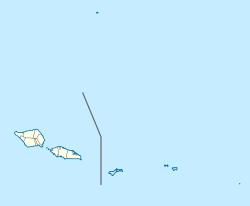| Silisili | |
|---|---|
| Mount Silisili | |
 Silisili in 2018 | |
| Highest point | |
| Elevation | 1,858 m (6,096 ft) [1] |
| Prominence | 1,858 m (6,096 ft) [1] |
| Listing | Country high point Ultra Ribu |
| Coordinates | 13°37′06″S172°29′09″W / 13.61833°S 172.48583°W [2] |
| Geography | |
| Location | Samoa |
Mount Silisili is the highest peak in Samoa and the Samoa Islands chain. It is located in the centre of a mountain chain running the length of Savai'i island. Mount Silisili is ranked 24th by topographic isolation.
Contents
Mount Silisili rises to a height of 1,858 m. [3] The word silisili means highest in reference to height, in the Samoan language.
Savai'i is the largest shield volcano island in the South Pacific.
